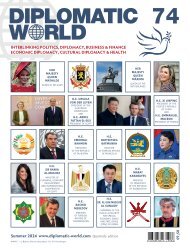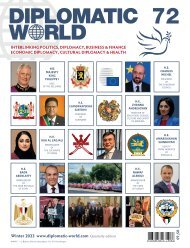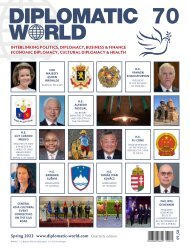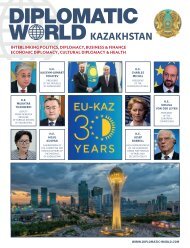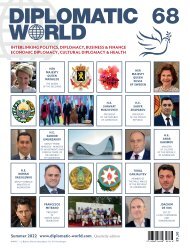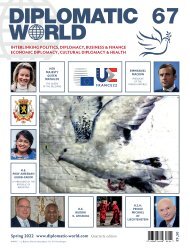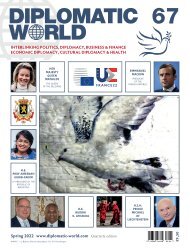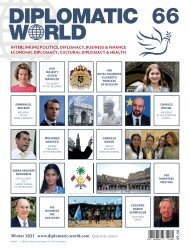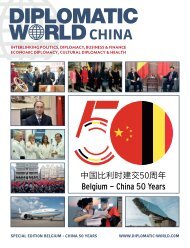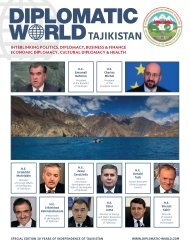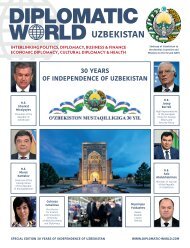Diplomatic World_69
Create successful ePaper yourself
Turn your PDF publications into a flip-book with our unique Google optimized e-Paper software.
include the St Cecilia in Ecstasy (1518, Pinacoteca in Bologna),<br />
with its extraordinary foreground still-life of musical instruments;<br />
the harmonious Alba Madonna (1510, National Gallery of Art,<br />
Washington, DC); the late Madonna of the Rose (c. 1518-20, Museo<br />
del Prado, Madrid), completed with the help of an assistant.<br />
Raphael’s Madonnas have to be considered in two categories.<br />
One comprising works done in Florence and the others in Rome.<br />
The repeated compositional strategy (Leonardian triangles)<br />
reveals a huge complexity of figural, postural, light-and-shade<br />
and detail variation. Each Madonna undergoes emotional and<br />
tonal changes, each unique, but everything relating to everything.<br />
Other highlights are: the Portrait of Baldassare Castiglione (c.<br />
1514-15) and the late Self Portrait with Friend (c. 1518-20), both<br />
from the Louvre Museum.<br />
Fresco, The School of Athens, 1509/11, Stanza della Segnatura, Vatican Palace<br />
Raphael’s splendid experimentation culminated in 1507 with his<br />
painting, ‘La Belle Jardinière’. That same year, Raphael created<br />
his most ambitious work in Florence, ‘The Entombment’, which<br />
his art is the paragon of ideal perfection and aesthetic excel-<br />
was reminiscent of the ideas which Michelangelo had expressed<br />
lence.<br />
in his ‘Battle of Cascina’.<br />
Esterhazy Madonna , panel 28,5 x 21,5 cm(1508) Museum of Fine Arts Budapest,<br />
inv. 71 can be juxtaposed with a preliminary drawing from the Uffizi illustrated<br />
hereunder (pricked for transfer, but not for the Esterhazy painting), this indicates<br />
Raphael’s combinatorial and cumulative approach.The painting is more monumental<br />
than the draft. The changes are subtle, but significant.<br />
Madonna del Grandluca, panel 84,4 x 55,9 cm (c.1505-06) © Palatine Gallery,<br />
Uffizi inv. 1912 n° 178.<br />
Raphael moved to Rome in 1508. Under Pope Julius II’s patronage,<br />
from 1509 to 1511, Raphael realized one of the High<br />
Renaissance’s most highly regarded fresco cycles in the<br />
Raphael’s trajectory from Urbino to Rome, implies to study his<br />
use of sources and their emulation by him. It explains his creative<br />
process, starting with a quickly drawn sketch (primo pensiero),<br />
followed by studies of figures. Then followed a compositional<br />
Vatican’s Stanza della Segnatura, including: ‘The Triumph of<br />
study and other nude studies to precise individual figures. The<br />
Religion’ and ‘The School of Athens’. Here, Raphael expressed<br />
modello in chalk (or the cartoon) prepared the finished painting<br />
In 1494, brought up by his uncle, a priest, Raphael took over the<br />
influenced by Perugino. Two year later, he attacks effortless<br />
the humanistic philosophy learned early at the Urbino court.<br />
(or fresco/tapestry).<br />
daunting task of managing his father’s workshop. Rapidly, he<br />
a much more complicated and extra-large composition, ‘The<br />
Raphael painted another fresco cycle in the Vatican in the<br />
understood the art of learning from others. As a teen, he made<br />
his earliest paintings for churches in the nearby Umbrian cities<br />
of Città di Castello (Church of San Nicholas) and Perugia. His<br />
Coronation of the Virgin’ (Pala Oddi, 1504, 267 x 163 cm Vatican<br />
Museums), in a less theatrical style. While painting the ‘Mond<br />
Crucifixion’ (circa 1502), The ‘Three Graces’ (circa 1503), ‘The<br />
Stanza d’Eliodoro, featuring ‘The Expulsion of Heliodorus’,<br />
‘The Miracle of Bolsena’, ‘The Repulse of Attila from Rome’ and<br />
‘The Liberation of Saint Peter’. In Rome in the night of 6 on 7<br />
ARCHITECTURE<br />
success quickly surpassed his father’s and won him major public<br />
Knight’s Dream’ (1504), he supplied drawings to other artists for<br />
April 1520, Raphael’s 37th birthday, he died suddenly after 8<br />
By 1514, Raphael had achieved fame for his work at the Vatican<br />
commissions. Raphael’s precocious ability to fuse minute obser-<br />
them to use, such as for his friend Bernardino di Betto, called<br />
days of extreme fever, while working on his largest painting on<br />
and was able to hire a crew of assistants to help him finish paint-<br />
vation and rich imagination into elegant designs made him one of<br />
Pintoricchio (c. 1454-1513). The latter, who introduced Raphael<br />
canvas, ‘The Transfiguration’ (commissioned in 1517). At his<br />
ing frescoes in the Stanza dell’Incendio, freeing him up to focus<br />
the finest painters in town.<br />
in Perugia, was the first artist to take a serious interest in the<br />
funeral mass at the Vatican, his unfinished painting was placed<br />
on other projects. While Raphael continued to accept commis-<br />
decorative painting of antiquity (grotesque), after the rediscovery<br />
on his coffin stand. In less than five years, he established himself<br />
sions – including portraits of Popes Julius II and Leo X, he had<br />
Late 1501 or early 1502, Pietro Vannunci known as Perugino<br />
of the Domus Aurea, Nero’s Palace (r. AD 54-68), then under-<br />
as the city’s major artist, much to the fury of Michelangelo.<br />
begun to work on architecture. After architect Donato Bramante<br />
(14<strong>69</strong>-1523), invited Raphael, then active in Città del Castello,<br />
ground as in a ‘grotto’.<br />
died in 1514, the pope hired Raphael as his chief architect.<br />
to become his apprentice in Perugia (Umbria), when Perugi-<br />
His tapestry designs (to be seen in the Victoria & Albert Museum,<br />
Under this appointment, Raphael created the design for a chapel<br />
no worked on frescoes at the Collegio del Cambia. Raphael is<br />
In 1505, Raphael left Perugino and moved to Florence, where he<br />
London) excel by their virtuosity, challenging the craftsmanship<br />
in Sant’ Eligio degli Orefici. He also designed Rome’s Santa<br />
documented there in January and March 1503. The apprentice-<br />
was heavily influenced by the works of the Italian painters Fra<br />
of the Brussels weavers. He became an explorer and curator of<br />
Maria del Popolo Chapel and an area within Saint Peter’s new<br />
ship lasted four years until late 1505 and changed his style, now<br />
Bartolommeo, Leonardo da Vinci, Michelangelo and Masaccio,<br />
Rome’s art and architecture of Antiquity and engaged with art<br />
basilica. Raphael’s architectural work was not limited to religious<br />
showing a more intense engagement with Perugino than before.<br />
without being overruled by them. He animated his figures with a<br />
theory. Together with his friend and scholar Baldassare Castigli-<br />
buildings. It also extended to designing palaces, honouring the<br />
Raphael developed his unique painting style through observa-<br />
sense of emotional intimacy and restraint, adopting at the same<br />
one, he wrote a letter to Pope Leo X explaining his project to pre-<br />
classical sensibility of his predecessor, Donato Bramante, and his<br />
tion, admiration of others’ achievements, his love for Antique<br />
time Michelangelo’s dynamic expressiveness. Capturing the<br />
serve antique architecture (X11725, Archivo di Stato di Mantova).<br />
use of ornamental details. They defined the architectural style of<br />
sculpture and drawing after nature and in anatomical theatres.<br />
power of a mother’s love for her child, he initiated there a series<br />
He became the architect of the reconstruction of the ‘Rome of<br />
the Late- Renaissance and Early-Baroque periods.<br />
of ‘Madonnas’, establishing a new devotional canon of delicate<br />
the Caesars’. In 1514, Pope Julius II hired Raphael (31 years old)<br />
But already early on, the contribution of his assistants, apparent-<br />
sensual tempered beauty which lasted over centuries. Raphael<br />
as his chief architect, at the moment he completed his last<br />
All photos: Jan DE MAERE<br />
ly local artists, is adamant in the execution of the subsidiary parts<br />
produced these through the emulation of Leonardo da Vinci’s<br />
painting in his series of the “Madonnas,” ‘the Sistine Madonna’.<br />
of his works, as we see in the ‘Colonna Altarpiece’ (1504/05).<br />
work. Raphael’s best-loved Madonnas are: the melancholic<br />
Raphael was buried in the Pantheon, admired and revered by<br />
One of his early works is the ‘Resurrection of Christ’ (panel 56,5<br />
Madonna del Granduca (Firenze, c. 1505-06)—and the idealised<br />
popes, cardinals, princes and artists all over Europe for his<br />
x 47 cm, 1499/1500, Museo de Arte Sao Paolo) is still strongly<br />
beauty, La Donna Velata (Rome, c. 1512-15). Other highlights,<br />
clear-sighted vision on his art and that of his time. Even today,<br />
202 203




